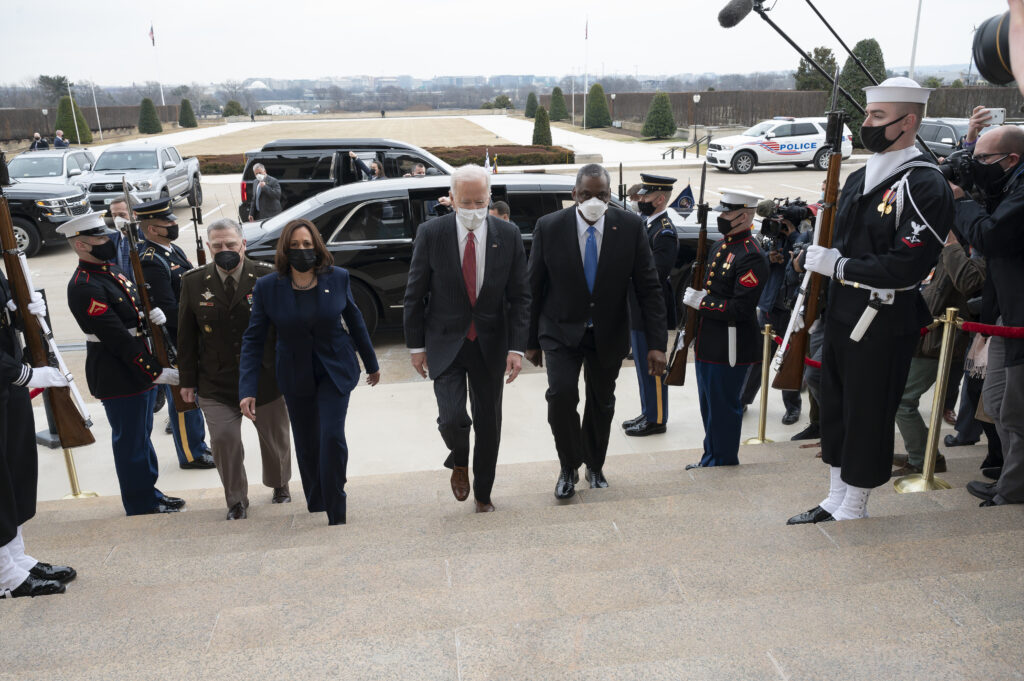
President Joe Biden and Vice President Kamala Harris at the Pentagon, with Secretary of Defense Lloyd Austin and Chairman of the Joint Chiefs of Staff Army Gen. Mark Milley
WASHINGTON: In a return to budgetary order after 20 years of paying for wars in Iraq, Afghanistan and Syria outside of the defense budget, the Biden administration is moving the Overseas Contingency Operations funding back into the base budget for 2022.
The move comes as part of the White House’s 2022 budget request as the administration looks to wind down the presence of thousands of US troops on the ground in Central Command’s area of responsibility.
The change is part of President Biden’s $715 billion request to fund the Pentagon in 2022, a slim 1.7% increase from the 2021 spending plan. The so-called “skinny” budget, released this morning, only includes the toplines for federal agencies, but is sure to fuel heated debate on Capitol Hill.
One of the big winners in the budget proposal is the State Department, which sees a $6.8 billion increase in the budget — or a 12% uptick over 2021 — to $63.5 billion, a request in keeping with the Biden administration’s focus on buttressing diplomacy to rebuild relationships strained by the last four years. It also signals the ascension of diplomats after two decades where the military played a larger role in foreign relations.
Importantly, the budget also appears to invest heavily in research and development and bringing high-tech manufacturing back to the United States, areas which affect the Pentagon’s own modernization priorities — but the modest increase will surely draw the ire of Capitol Hill.
The $715 billion topline increases to $753 billion once other defense-related accounts such as the Energy Department nuclear weapons modernization accounts are added.
That 1.7% increase in the base budget will be a sticking point on both sides of the aisle in Congress, with Republicans calling for increases in the 3% to 5% range, and many progressive groups demanding cuts in defense spending to reduce the deficit and spend more heavily on education and other domestic programs.
Overall, the non-defense federal budget shoots up 16 percent in the request, leaving the Pentagon — whose funding almost equals the rest of the federal government combined — well behind the trend curve.
“The White House is asking for a fight,” Mackenzie Eaglen, a budget expert at the American Enterprise Institute, believes. “I think it’s going to cause furor on Capitol Hill. It is not keeping pace with inflation…and the only federal entity on a fiscal diet is the US military? That’s just not copacetic.”
A White House official told reporters this morning that the defense budget “should be seen in the context [of] both what we’re presenting on the non-defense side and the defense side of the equation. Part of the complaint has been that there were not the same investment levels on the non-defense side [in recent years], that is not the case in this budget request.”
The official added, “the focus will be on investments on non-defense, but also ensuring the Defense Department he can continue its strategic goals as we outcompete China, and as we ensure that the men and women in uniform have everything that they need.”
Former Congressman John Tierney, director for the progressive Council for a Livable World, said in a statement that the Pentagon’s budget “should still be further reduced during congressional budget consideration” since “much work remains to divest ourselves of legacy weapons systems and strategies intended to fight the Cold War. We must reduce wasteful spending to meet the moment we find ourselves in now.”
The progressive wing of the Democratic Party is outnumbered in both the House and Senate, though it’s members are certain to continue their fight as the budget moves along.
While no numbers were offered, White House documents released this morning said the budget request “more than doubles funding for manufacturing programs at the National Institute of Standards and Technology (NIST), enabling the establishment of two new Manufacturing Innovation Institutes, in addition to institutes previously launched by the Departments of Defense and Energy.”
That effort seeks to re-establish some high-tech manufacturing in the United States, including semiconductors and other computing materials critical to the Pentagon, which now relies on parts made in China and elsewhere.
The document also says the full budget, which will be released later this spring, “prioritizes defense research, development, test, and evaluation funding to invest in breakthrough technologies that would drive innovation and underpin the development of next-generation defense capabilities.”
The budget will also support “ongoing” nuclear modernization programs, fund further development and testing of hypersonic strike capabilities, “proposes executable and responsible investments in the U.S. Navy fleet,” and pledges to “divest legacy systems and programs to redirect resources from low- to high-priority programs, platforms, and systems.”
America’s crisis of repetition is hurting national security
In this op-ed, Nadia Schadlow calls for an end to the “mind-numbing cycle of far too many studies coming out of the Pentagon and the US government as a whole — with little progress on implementation.”



























